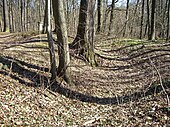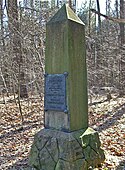Oberholz (forest area in Saxony)
The Oberholz is a forest area in the municipality of Großpösna in the Leipzig district . An adjacent part of Großpösna settlement and a stop on the Leipzig – Geithain railway line also bear the same name .
geography
The approximately 600 hectare forest area is located south of Großpösna on the Liebertwolkwitzer ground moraine plate . The distance to the northwest lying Leipzig is about 14 kilometers. The places surrounding the Oberholz are starting clockwise from Großpösna Threna , Belgershain , Oelzschau , Pötzschau , Dreiskau-Muckern and Störmthal . The Oberholz lies on the watershed between the Parthe and the Pleiße at an altitude of 150–160 meters above sea level. It is drained to the north by the Pösgraben , which flows into the Parthe via Ochsengraben and Threne in Zweenfurth . To the south there are the Oberholzgraben, which (not always water-bearing) flows into the Gösel at Dahlitzsch , and the Schlumper , which formerly flowed into the Gösel in Magdeborn and now flows into the Störmthaler See .
history
Remains of historical ramparts in the northern part of the Oberholz indicate an early settlement. A village that had already fallen into desolation (Wüstalbrechtshain) is mentioned for 1393 . At that time, a large part of the Oberholz area already belonged to the Dominican monastery in Leipzig . In the course of the Reformation , the monastery was closed. With the donation of the monastery property by Duke Moritz von Sachsen to the University of Leipzig on April 22, 1544, the Oberholz also became their property. At first the university professors only used the forest for firewood, but in the 18th century it was also used for their recreation. At the beginning of the 19th century, the planting of useful woody trees resulted in the transition to targeted forest management. At that time there was already a forester's house at the northeast end. There was a university forester until 1913. The surrounding manors also owned parts of the forest. After 1945 the forest was administered by the State Forestry Company Grimma, and since 1990 by the Leipzig and Naunhof Forestry Offices .
The Leipzig – Geithain railway line, opened in 1887, touched the Oberholz, and from April 20, 1893 there was also a stop here. This gave the people of Leipzig the opportunity to use the Oberholz for excursions more easily than before. With the Hotel Waldschloss Oberholz, a high-performance catering business soon emerged near the station. A memorial stone was erected on the occasion of the 350th anniversary of the donation by Duke Moritz. In the first third of the 20th century, home construction began around the train station. In the meantime, the entire area between the railway line (tree line) and the road to Grimma (S38) has been filled with residential buildings.
On Oberholz 1936 was druggists teaching garden that from 1948 the Department of Education of the City of Leipzig has been allocated and from then on the training of druggists, pharmacists and diet chefs served. The facility with medicinal and aromatic plants, today's and no longer in use plants as well as plants used in homeopathy is also open to interested visitors.
Several hiking trails are currently marked in Oberholz, including a 7.5-kilometer nature and hunting trail. According to an idea of the male choir Großpösna, 12 boards with melodies and lyrics of folk songs as well as information about the composer were set up on a “path of songs”.
nature
The Oberholz is a mixed forest with coniferous but larger deciduous forest parts. There are a total of 13 tree species. The conversion to faster growing conifer species, which was generally carried out in the 19th century, only took place to a small extent in Oberholz. The large, more translucent hardwood proportions show a great diversity of species at all heights of the forest, the canopy, shrub, herb and soil layers. Lesser celandine , wood anemones , lungwort , chickweed and lily of the valley occur over a large area . Arum and wild garlic can also be found at Pösgraben .
Three areas are designated as area natural monuments. In one of these, in the northern part, the original “pedunculate oak-hornbeam forest” is particularly well preserved with linden , ash , birch , alder and three types of maple . The second is the largest occurrence of daphne in Saxony in a swampy alder forest . The third applies to the orchid locations on the wet meadows in the immediate vicinity of the forest. The broad-leaved orchid is the most important representative. But cowslips , marsh marigolds , marsh sword lily and brook avens also grow .
The fauna is represented in the full width usual for the mixed forest. Deer - fallow deer and wild boar as well as fox , badger , marten , polecat and weasel occur. Of the numerous bird species, only the red and black kite but also several species of owls are mentioned here. For amphibians and reptiles , reference is made to 3300 common toads , which were counted during a spawning migration in 1994.
The teaching and experimental material
In 1893, the head of the Agricultural Institute of the University of Wilhelm Kirchner relocated the test field of the institute from Leipzig-Lindenau, where space was needed in terms of urban planning, to Oberholz near the forestry department. Residential and farm buildings were built. After repairing damage from the Second World War , several new buildings were added from 1951. In 1973 the arable land was transferred to the Wachau Cooperative Plant Production Department . In 1992 it was returned to the university property. Under the leadership of the Faculty of Veterinary Medicine, this now serves the practical training of veterinary medicine students and as an experimental basis for the University's Faculty of Veterinary and Human Medicine. The field yields are used to supply the cows, pigs, sheep and horses as well as a herd of fallow deer on the estate.
literature
- The Oberholz . In: August Schumann : Complete State, Post and Newspaper Lexicon of Saxony. 7th volume. Schumann, Zwickau 1820, pp. 469–471.
Individual evidence
- ↑ a b All about Oberholz . Published by the Großpösna municipal administration.
- ↑ a b Horst Riedel: Stadtlexikon Leipzig A - Z . PRO LEIPZIG, Leipzig 2005, ISBN 3-936508-03-8 . P. 442
- ↑ Meilenblätter von Sachsen 1: 12000 (Berlin copy), recorded 1780–1806 under the direction of Friedrich Ludwig Aster , sheet B43, on: deutschefotothek.de
- ↑ Railway stations in Saxony (accessed on January 3, 2013)
Web links
- The Oberholz on the website of the community Großpösna
- Botanical garden for herbs and medicinal plants Oberholz
Coordinates: 51 ° 14 ′ 52.6 " N , 12 ° 30 ′ 37.2" E







